So, as part of my little teledildonics project, I think it would be useful to have capacitive sensors to determine what you’re doing with the toy.
Capacitive sensing in silicone is tricky. Silicone is a great insulator so you need to add something conductive. You don’t want anything hard in the silicone which will make it less safe to play with. I thought about using conductive paint and then layering over a layer of silicone protectant. That might still be a good option, but I worried about the durability of the paint, especially if you consider that silicone can stretch quite a bit.
Ideally, I would use some kind of “conductive silicone”. Search online for this term and you’ll probably find this instructable for conductive silicone. It piqued my interest, not least because the person who came up with the idea had sex toys in mind!
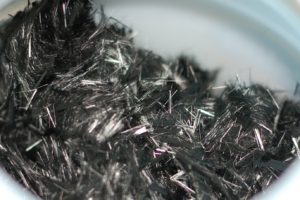
So, I set about to recreate this material myself. I had a few reservations, especially around safety. Carbon fiber is dangerous if breathed in. We don’t know the long term affects but we think they may be similar to asbestos. You can also easily cut yourself with it if you put it in a resin. So, it was with much caution that I began my experiment.
The recipe I tried is as follows:
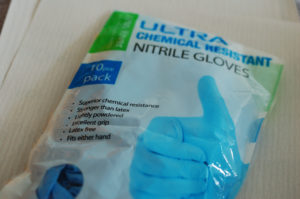
Safety equipment:
- Nitrile gloves – these will not prevent your Platinum silicone from curing. Anything with sulfur in it is a bad idea.
- Face mask – to prevent me breathing in the carbon fibers. The jury is still out as to whether breathing this stuff causes cancer, but there’s enough research out there to say that it might.
Materials:
- 6mm long carbon fibers
- 10 shore “dragon’s skin” platinum cure silicone (very fast curing) This silicone is body safe and 10 shore (which refers to the softness) is apparently suitable for a skin-like texture.
Equipment:
- isopropyl alcohol
- plastic cups
- plastic knives and spoons
- Ice cube tray
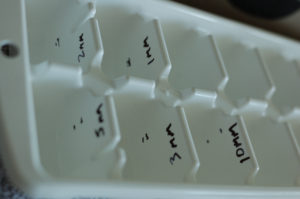
It was with visions of science that I drew little markets in my ice cube tray. I was hoping to test how much capacitance I could detect between various thicknesses of non-conductive silicone.
I took a plastic table spoon full of the carbon fibers and doused them in isopropyl alcohol. I believe the idea is the alcohol is supposed to separate the fibers and dry out fast enough so as not to inhibit the curing of the silicone. Truth be told I didn’t notice any difference in the nature of the fibers. They’re very weird to work with, they behave more like clumps of shortly cut hair than how I would imagine carbon to behave.
After all my safety precautions, I was so vigorous stirring my little mixture that I splashed isopropyl alcohol in my eye (don’t do that)! A bit of water and a visual inspection confirmed I was none the worse for wear.
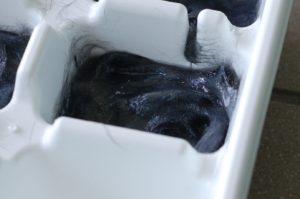
I then quickly moved on to making the silicone. I measured 25 ml of “Part A”, and added in 25 ml of “Part B”. I immediately regretted getting the “Very Fast” cure silicone. It started thickening pretty quickly! I added the carbon fibers (they were still pretty wet) and stirred it all like crazy.
The goop did not pour well, but spooned reluctantly into the prepared ice cube tray. The carbon fibres gave it a “stringy” quality, making it difficult (though not impossible) to work with.
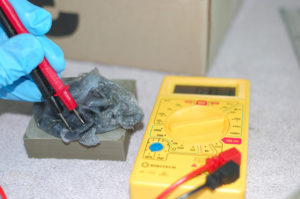
Initial tests showed that the material was indeed quite conductive. The conductivity was not uniform, just like the material itself was not uniform, but it’s good enough for my purposes.
After about 30 minutes, I made a second batch of silicone, this time without the added carbon fibres and layered it on.
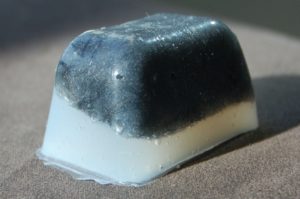
Another 30 minutes later and I had some very serviceable carbon fibre / silicone “cubes”. The material itself is actually quite beautiful, it has a silvery sheen and in some places you can see the fibres swirling through the material, making for very pretty shapes. I immediately grabbed it with my hands. It didn’t feel rough or spikey as I expected, it actually felt quite soft and ductile. I stretched it.
The conductive silicone does not spring back into form as well as pure silicone, but it holds together pretty well. This resilience combined with the fact that it felt pretty safe got me feeling hopeful. Maybe the silicone effectively immobilises the carbon, making it safe?
Closer inspection proved this to not be the case. In sunlight, you can see the little carbon fibres crisscrossing each other on the surface. By pulling the material, I was also able to get some fibres to stick out.

To be fair, the fibres are very small and will not cut you, they bend as you press them. I expect that they could cause itching, like any fine hairs. My hands feel itchy now, either from my imagination or from playing with the material. I also know that carbon fibre will break if pulled. Imagine fragments of this stuff breaking off and getting into sensitive areas?
No, if we’re going to have conductive silicone, it will need to be covered with at least 0.5 mm of normal silicone. Next test will be how much of this protective silicone I can have before the capacitive sensing stops working.